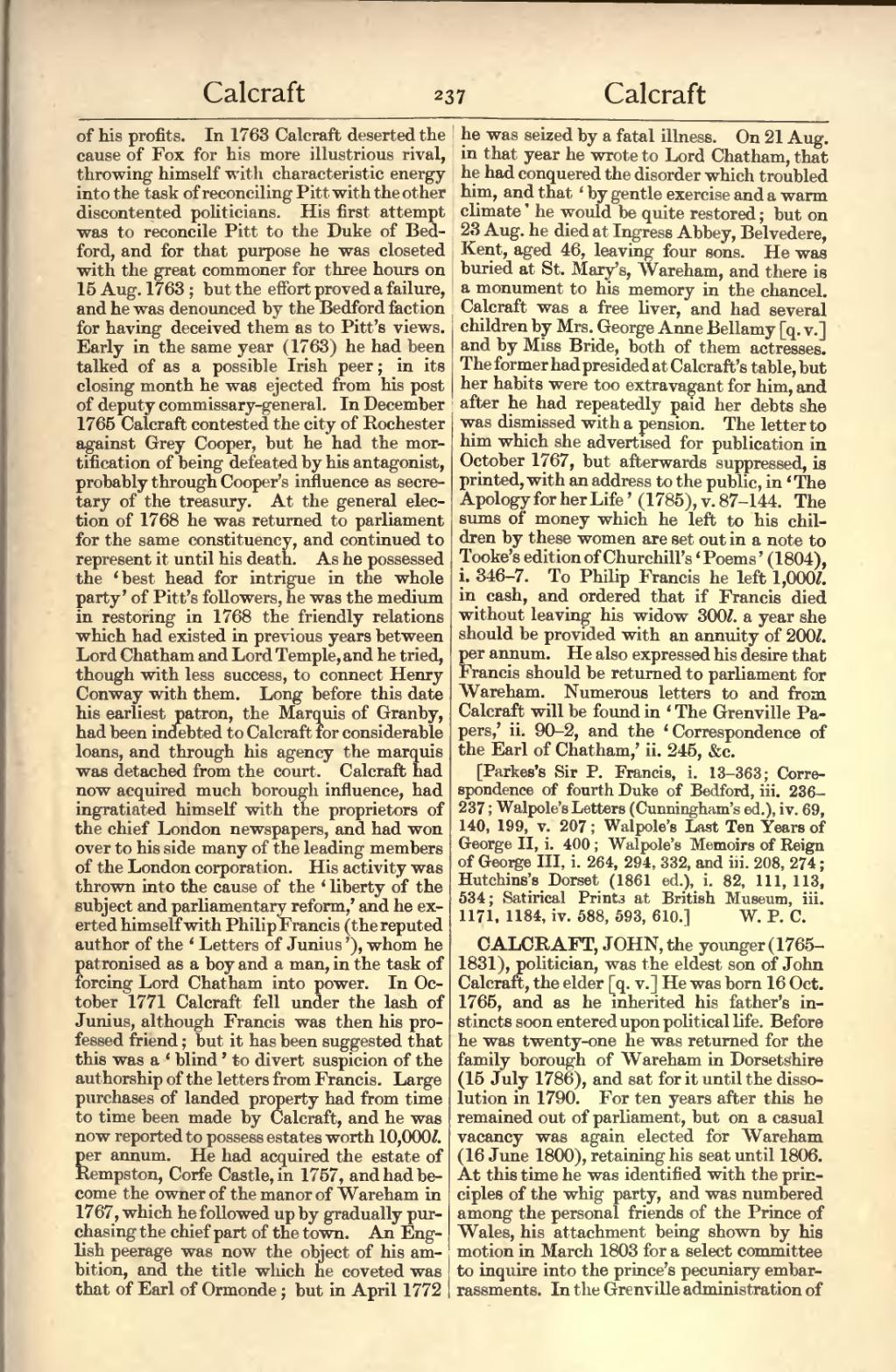of his profits. In 1763 Calcraft deserted the cause of Fox for his more illustrious rival, throwing himself with characteristic energy into the task of reconciling Pitt with the other discontented politicians. His first attempt was to reconcile Pitt to the Duke of Bedford, and for that purpose he was closeted with the great commoner for three hours on 15 Aug. 1763; but the effort proved a failure, and he was denounced by the Bedford faction for having deceived them as to Pitt's views. Early in the same year (1763) he had been talked of as a possible Irish peer; in its closing month he was ejected from his post of deputy commissary-general. In December 1765 Calcraft contested Rochester against Grey Cooper, but he had the mortification of being defeated, probably through Cooper's influence as secretary of the treasury. He was M.P. for Calne 1766–8. At the general election of 1768 he was returned to parliament for Rochester, and continued to represent it until his death. As he possessed the ‘best head for intrigue in the whole party’ of Pitt's followers, he was the medium in restoring in 1768 the friendly relations which had existed in previous years between Lord Chatham and Lord Temple, and he tried, though with less success, to connect Henry Conway with them. Long before this date his earliest patron, the Marquis of Granby, had been indebted to Calcraft for considerable loans, and through his agency the marquis was detached from the court. Calcraft had now acquired much borough influence, had ingratiated himself with the proprietors of the chief London newspapers, and had won over to his side many of the leading members of the London corporation. His activity was thrown into the cause of the ‘liberty of the subject and parliamentary reform,’ and he exerted himself with Philip Francis (the reputed author of the ‘Letters of Junius’), whom he patronised as a boy and a man, in the task of forcing Lord Chatham into power. In October 1771 Calcraft fell under the lash of Junius, although Francis was then his professed friend; but it has been suggested that this was a ‘blind’ to divert suspicion of the authorship of the letters from Francis. Large purchases of landed property had from time to time been made by Calcraft, and he was now reported to possess estates worth 10,000l. per annum. He had acquired the estate of Rempston, Corfe Castle, in 1757, and had become the owner of the manor of Wareham in 1767, which he followed up by gradually purchasing the chief part of the town. An English peerage was now the object of his ambition, and the title which he coveted was that of Earl of Ormonde; but in April 1772 he was seized by a fatal illness. On 21 Aug. in that year he wrote to Lord Chatham, that he had conquered the disorder which troubled him, and that ‘by gentle exercise and a warm climate’ he would be quite restored; but on 23 Aug. he died at Ingress Abbey, Belvedere, Kent, aged 46, leaving four sons. He was buried at St. Mary's, Wareham, and there is a monument to his memory in the chancel. Calcraft was a free liver, and had several children by Mrs. George Anne Bellamy [q. v.] and by Miss Bride, both of them actresses. The former had presided at Calcraft's table, but her habits were too extravagant for him, and after he had repeatedly paid her debts she was dismissed with a pension. The letter to him which she advertised for publication in October 1767, but afterwards suppressed, is printed, with an address to the public, in ‘The Apology for her Life’ (1785), v. 87–144. The sums of money which he left to his children by these women are set out in a note to Tooke's edition of Churchill's ‘Poems’ (1804), i. 346–7. To Philip Francis he left 1,000l. in cash, and ordered that if Francis died without leaving his widow 300l. a year she should be provided with an annuity of 200l. per annum. He also expressed his desire that Francis should be returned to parliament for Wareham. Numerous letters to and from Calcraft will be found in ‘The Grenville Papers,’ ii. 90–2, and the ‘Correspondence of the Earl of Chatham,’ ii. 245, &c.
[Parkes's Sir P. Francis, i. 13–363; Correspondence of fourth Duke of Bedford, iii. 236–237; Walpole's Letters (Cunningham's ed.), iv. 69, 140, 199, v. 207; Walpole's Last Ten Years of George II, i. 400; Walpole's Memoirs of Reign of George III, i. 264, 294, 332, and iii. 208, 274; Hutchins's Dorset (1861 ed.), i. 82, 111, 113, 534; Satirical Prints at British Museum, iii. 1171, 1184, iv. 588, 593, 610.]
CALCRAFT, JOHN, the younger (1765–1831), politician, was the eldest son of John Calcraft, the elder [q. v.] He was born 16 Oct. 1765, and as he inherited his father's instincts soon entered upon political life. Before he was twenty-one he was returned for the family borough of Wareham in Dorsetshire (15 July 1786), and sat for it until the dissolution in 1790. For ten years after this he remained out of parliament, but on a casual vacancy was again elected for Wareham (16 June 1800), retaining his seat until 1806. At this time he was identified with the principles of the whig party, and was numbered among the personal friends of the Prince of Wales, his attachment being shown by his motion in March 1803 for a select committee to inquire into the prince's pecuniary embarrassments. In the Grenville administration of
